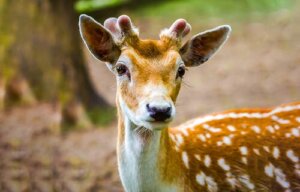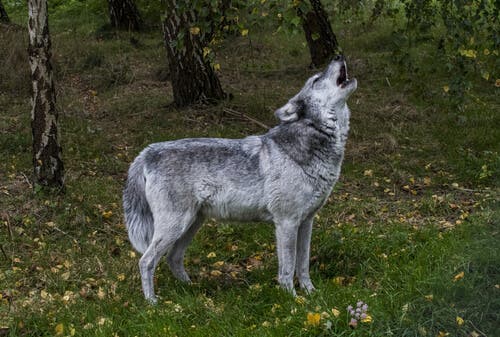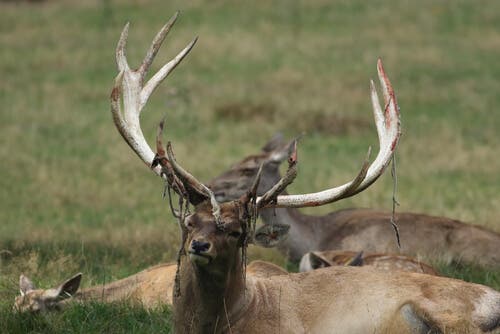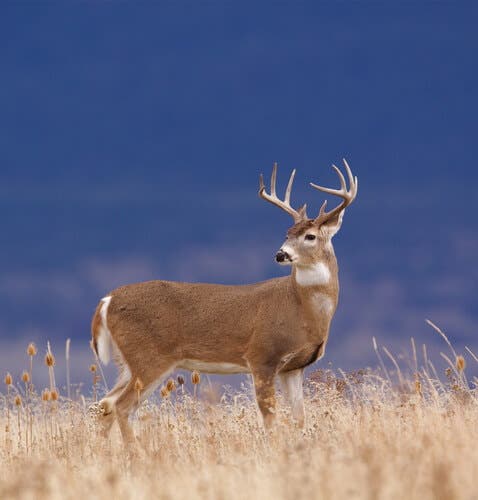8 Subspecies of Deer

Did you know that there are at least 25 subspecies of deer around the world today? Most of them live in Eurasia, although they also live in Africa, America, and Oceania. We’ll tell you about some of them in this article.
Subspecies of deer in Eurasia and Africa
Deer live in almost all European territories, as well as North Africa and West Asia. Some of the subspecies of deer that we can find in these regions are:
1. Red deer
This deer, while smaller than its European relative – that also lives in Spain – is a majestic animal with reddish-brown fur and lighter belly that becomes more grayish in winter.
Males can weigh 440 pounds – females reach half that weight – and have large horns, just like other deer. The females of this species have small bumps on the upper part of the skull.
2. European deer
One of the largest wild herbivores on the continent and similar in color and appearance to the red deer. They live in dense forests and mountain ranges, and their habits differ according to human presence. They can be nocturnal, apart from when in heat, or diurnal. The wolf is the European deer’s only predator.

Although males have antlers they don’t use them to defend themselves; instead, they run away to avoid being hunted.
3. Siberian musk deer
Unlike the other deer, Siberian musk males don’t have antlers. Their body is medium-sized – about three feet high – and their legs are good for jumping and not sinking into the snow during the winter.
They’re herbivores and feed on lichens, leaves, stems, mosses, crusts, and mushrooms. They live in solitude – only meeting with others to reproduce – and are more active at dawn and dusk.
4. Bactrian deer
Also known as Russian Turkestan or Bukhara deer. They live in Uzbekistan and Afghanistan, although its populations are becoming smaller, partly due to the frequent conflicts in these countries.

Bactrian deer prefer a particular habitat called the Tugai forest, which is made up of valleys, plains, and large amounts of vegetation. This is where they’ve evolved for centuries.
Subspecies of deer in the Americas
Natives of this continent also call them ‘elks’ and they more commonly live in the northern regions. People here believe they’re harmful to the ecosystem, particularly in Chile and Argentina, and they hunt them. The subspecies of American deer are:
1. Yellowstone deer
They’re found in the Rocky Mountains, southern Canada (Alberta and British Columbia), as well as in the western and central United States (Utah, Oregon, Washington, Montana, Idaho, Nevada, Arizona, Colorado, and Dakota).
Their name comes from the fact that they’re one of the most popular inhabitants of Yellowstone National Park.
They’re a large deer. Males reach six feet in height and weigh almost 800 pounds. Their antlers measure 4.9 feet in length. Females have darker fur and weigh about 440 pounds.
2. Manitoba deer
Manitoba deer live in this province of Canada in designated wilderness areas such as Riding Mountain, Prince Albert, and Duck Mountain National Parks.

They’re similar to the Yellowstone deer, but shorter in height and have darker fur.
3. Roosevelt Deer
These are the largest deer subspecies, with males reaching 1322 pounds. They’re named after former President Theodore Roosevelt, an amateur naturalist.
The males’ antlers are webbed and have several tips. They live in western North America (Vancouver, Oregon, and Washington).
4. California deer
The smallest of the American deer, and until 1870, they lived in Californian forests, meadows, and bushland. However, hunting and environmental destruction almost lead to their extinction. Fortunately, a reserve was created in the center of the State where they’ve been multiplying ever since.
Did you know that there are at least 25 subspecies of deer around the world today? Most of them live in Eurasia, although they also live in Africa, America, and Oceania. We’ll tell you about some of them in this article.
Subspecies of deer in Eurasia and Africa
Deer live in almost all European territories, as well as North Africa and West Asia. Some of the subspecies of deer that we can find in these regions are:
1. Red deer
This deer, while smaller than its European relative – that also lives in Spain – is a majestic animal with reddish-brown fur and lighter belly that becomes more grayish in winter.
Males can weigh 440 pounds – females reach half that weight – and have large horns, just like other deer. The females of this species have small bumps on the upper part of the skull.
2. European deer
One of the largest wild herbivores on the continent and similar in color and appearance to the red deer. They live in dense forests and mountain ranges, and their habits differ according to human presence. They can be nocturnal, apart from when in heat, or diurnal. The wolf is the European deer’s only predator.

Although males have antlers they don’t use them to defend themselves; instead, they run away to avoid being hunted.
3. Siberian musk deer
Unlike the other deer, Siberian musk males don’t have antlers. Their body is medium-sized – about three feet high – and their legs are good for jumping and not sinking into the snow during the winter.
They’re herbivores and feed on lichens, leaves, stems, mosses, crusts, and mushrooms. They live in solitude – only meeting with others to reproduce – and are more active at dawn and dusk.
4. Bactrian deer
Also known as Russian Turkestan or Bukhara deer. They live in Uzbekistan and Afghanistan, although its populations are becoming smaller, partly due to the frequent conflicts in these countries.

Bactrian deer prefer a particular habitat called the Tugai forest, which is made up of valleys, plains, and large amounts of vegetation. This is where they’ve evolved for centuries.
Subspecies of deer in the Americas
Natives of this continent also call them ‘elks’ and they more commonly live in the northern regions. People here believe they’re harmful to the ecosystem, particularly in Chile and Argentina, and they hunt them. The subspecies of American deer are:
1. Yellowstone deer
They’re found in the Rocky Mountains, southern Canada (Alberta and British Columbia), as well as in the western and central United States (Utah, Oregon, Washington, Montana, Idaho, Nevada, Arizona, Colorado, and Dakota).
Their name comes from the fact that they’re one of the most popular inhabitants of Yellowstone National Park.
They’re a large deer. Males reach six feet in height and weigh almost 800 pounds. Their antlers measure 4.9 feet in length. Females have darker fur and weigh about 440 pounds.
2. Manitoba deer
Manitoba deer live in this province of Canada in designated wilderness areas such as Riding Mountain, Prince Albert, and Duck Mountain National Parks.

They’re similar to the Yellowstone deer, but shorter in height and have darker fur.
3. Roosevelt Deer
These are the largest deer subspecies, with males reaching 1322 pounds. They’re named after former President Theodore Roosevelt, an amateur naturalist.
The males’ antlers are webbed and have several tips. They live in western North America (Vancouver, Oregon, and Washington).
4. California deer
The smallest of the American deer, and until 1870, they lived in Californian forests, meadows, and bushland. However, hunting and environmental destruction almost lead to their extinction. Fortunately, a reserve was created in the center of the State where they’ve been multiplying ever since.
This text is provided for informational purposes only and does not replace consultation with a professional. If in doubt, consult your specialist.








